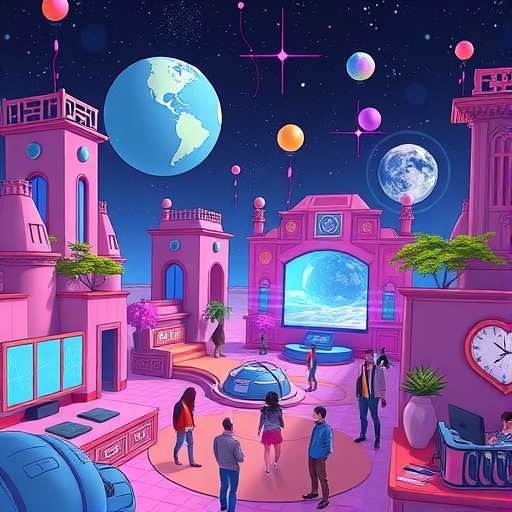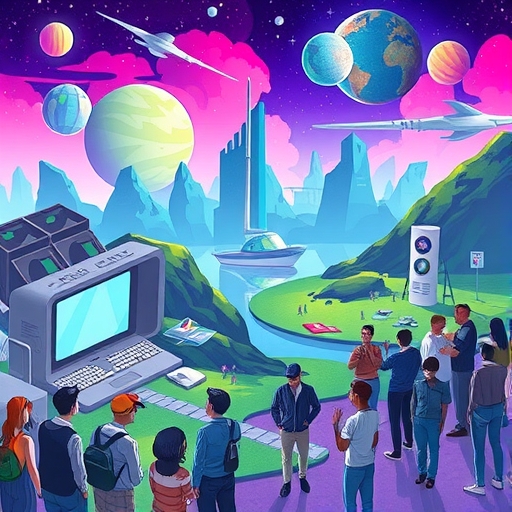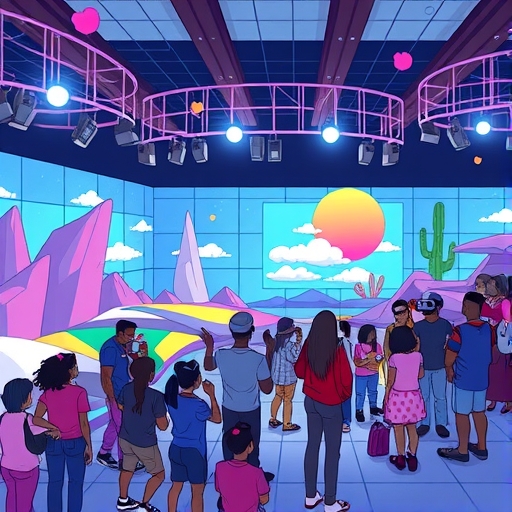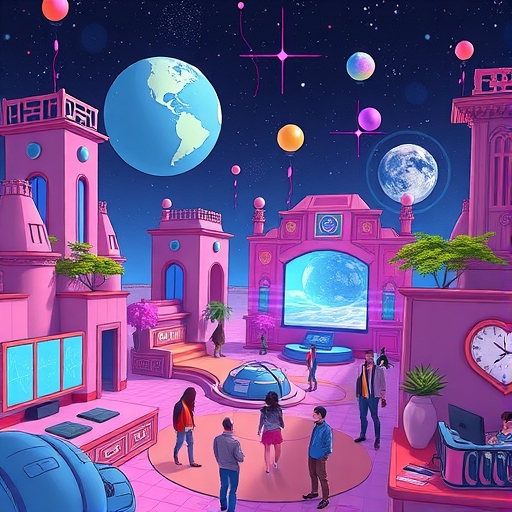Introduction: Stepping into the Decentralized Metaverse
Welcome to our exploration of Decentraland, a pioneering platform in the burgeoning world of the metaverse. Imagine a vast, digital universe where you, not a single corporation, hold the keys. This isn’t just a game; it’s a decentralized virtual world built on the Ethereum blockchain, offering a unique blend of creativity, social interaction, and economic opportunity.
For anyone looking to understand the practical application of blockchain technology beyond cryptocurrencies, Decentraland provides a compelling case study. It’s a place where digital assets have real ownership, and users actively participate in shaping the environment. Whether you’re an investor, a creator, a gamer, or simply curious, grasping the fundamentals of this platform is essential to understanding the future of online interaction and digital economies.
In this deep dive, we will navigate the core components that make up Decentraland, dissect its native token, MANA, examine the dynamics of its digital marketplace, and explore how a decentralized community governs this ever-expanding world. Prepare to uncover the layers of a complex ecosystem, moving from basic concepts to the intricate market forces at play.
Key aspects to consider:
- The decentralized nature of ownership.
- The importance of creativity and technological skills.
- The economic opportunities that arise from user-generated content.

Understanding Decentraland: A Foundation in the Metaverse
At its heart, Decentraland is a programmable virtual reality platform. Think of it as a digital realm comprising 90,601 parcels of LAND, its fundamental unit of real estate. Unlike traditional online games or virtual spaces where the creators own everything, each parcel of LAND in Decentraland is a non-fungible token (NFT), meaning it is unique and owned by a specific user on the Ethereum blockchain.
This ownership model is foundational. It grants users unprecedented control. You can develop your LAND parcel into anything you can imagine: a game, a scene, a digital store, an art gallery, or a space for social gatherings. The possibilities are constrained only by creativity and technical skill.
The platform provides a suite of tools, notably the Builder, which allows users, even those without coding experience, to create static or interactive Scenes. For more complex applications, developers can use the Decentraland SDK to build custom experiences, including full-fledged Games.
Your identity within this world is represented by a customizable Avatar. You can personalize its appearance with Wearables and express yourself through Emotes. These, too, are digital assets, often existing as NFTs, adding another layer to the platform’s economy and user expression.
Unlike centralized platforms that can change rules or shut down arbitrarily, Decentraland is designed to be open and persistent. Its protocol is open-source, allowing anyone to build upon it, fostering a truly decentralized ecosystem. This commitment to decentralization is a key characteristic, setting it apart from corporate-controlled metaverse visions.
| Feature | Description |
|---|---|
| Programmable Reality | Users can create interactive experiences. |
| Ownership Model | Each parcel is unique and secured as an NFT. |
| Decentralization | Open-source protocol fostering community building. |
Digital Real Estate in the Metaverse: The Concept of LAND
Just as physical real estate serves as the foundation for cities, LAND parcels are the bedrock of Decentraland’s virtual world, known collectively as Genesis City, along with connected Worlds. Each LAND parcel is a 16×16 meter square within the metaverse grid. Their finite nature – capped at 90,601 parcels – is a crucial economic factor, creating scarcity akin to prime locations in the physical world.
Owning LAND isn’t just about having a place to build; it’s about participating in the core economy. As a LAND owner, you possess a verifiable digital asset (the LAND NFT) on the blockchain. This ownership is immutable and transparent.
What can you do with your LAND? The most obvious is development, creating experiences for visitors. But you can also hold it as an investment, hoping its value appreciates as the platform grows. Furthermore, the ability to rent out your LAND parcel is a significant economic mechanism. This allows others to build experiences on your property without permanent ownership, fostering a rental market within the metaverse, creating passive income opportunities for owners and lowering entry barriers for creators who can’t afford to buy.
The value of a LAND parcel can be influenced by various factors within the metaverse:
- Its location (e.g., proximity to popular plazas or established districts).
- The traffic it receives.
- The quality and popularity of the experiences built upon it.
- The overall health and growth of the Decentraland ecosystem and the broader metaverse market.
Understanding the dynamics of LAND is paramount for potential investors or creators in Decentraland, as it represents the primary form of digital property and a key driver of economic activity.

Beyond LAND: Exploring Other Digital Assets (NFTs)
While LAND is the primary real estate asset, Decentraland’s economy is rich with other forms of digital property, predominantly in the form of NFTs. These assets allow for personalization, monetization, and enhanced experiences within the virtual world.
Wearables are perhaps the most common type of non-LAND asset. These are digital clothing, accessories, hairstyles, and other items that you can equip on your Avatar. Creators can design and mint unique Wearables, ranging from common items to rare, limited-edition pieces. Owning a Wearable as an NFT means it’s yours, verifiable on the blockchain, and you can wear it, trade it, or sell it on the marketplace.
Emotes are digital animations or gestures that your Avatar can perform. Like Wearables, they can be created and sold as NFTs, adding another layer of self-expression and collectible value.
Even your Avatar’s name can become a tradable asset. Decentraland offers the ability to register unique NAMEs linked to your wallet, often as NFTs, allowing you to establish your identity within the world and potentially monetize desirable or memorable handles.
More complex creations, such as interactive Scenes or even entire Games built on a LAND parcel, can involve multiple underlying assets or mechanisms for monetization, such as charging for access or selling in-game items. The creators of these experiences often leverage the platform’s economy to generate revenue from their digital endeavors.
The existence of these diverse digital assets, all secured by blockchain technology and existing as verifiable NFTs, underpins the potential for a vibrant, user-driven economy. As the NFT market matures, as noted by entities like the Decentraland Foundation, the focus is increasingly shifting from pure speculation towards the genuine utility these assets provide within the metaverse.
| Type of Asset | Description |
|---|---|
| Wearables | Digital clothing and accessories for Avatars. |
| Emotes | Animations or gestures for personal expression. |
| NAMEs | Unique identifiers registered as NFTs. |
The Decentraland Marketplace: A Hub for Digital Commerce
Where do all these digital assets – LAND, Wearables, Emotes, NAMEs, and others – change hands? The answer is the Decentraland Marketplace. This is the official, web-based hub where users can buy, sell, and manage their digital possessions. It serves as the central nervous system for the platform’s internal economy.
The Marketplace functions much like an online auction house and store. Listings display assets available for sale, their prices (typically denominated in MANA or sometimes Wrapped Ether (WETH)), and their ownership history recorded transparently on the blockchain.
Key functions of the Marketplace include:
- Buying Assets: You can browse available LAND parcels (by location, size, or price), Wearables (filtered by category, creator, or rarity), Emotes, and NAMEs, and purchase them directly if listed at a fixed price, or bid on them in an auction format.
- Selling Assets: Owners can list their digital assets for sale, setting a price or starting an auction.
- Managing Assets: The Marketplace allows users to see all the assets they own within Decentraland, verify their authenticity, and manage their properties.
- Renting LAND: A specific feature allows LAND owners to list their parcels for rent, specifying the duration and the rental fee. This facilitates temporary use and economic activity on land not actively used by its owner.
All transactions on the Marketplace use MANA as the primary currency (though WETH is also supported for some transactions, converting ultimately via smart contracts). A small transaction fee is typically charged, which is burned (removed from circulation) or directed to the Decentraland DAO treasury, adding to the platform’s economic loop.
Understanding the Marketplace is vital because it’s where the supply and demand for Decentraland’s core assets intersect, influencing their value and the overall health of the in-world economy. Its activity provides insights into user engagement and investment sentiment within the platform.

MANA: Fueling the Decentraland Economy and Governance
Every vibrant economy needs a medium of exchange, and in Decentraland, that role is filled by MANA. MANA is an ERC-20 token, a standard type of token on the Ethereum blockchain, making it easily tradable on cryptocurrency exchanges globally.
What does MANA do within Decentraland?
- Currency: It is the primary currency used to purchase LAND, Wearables, Emotes, NAMEs, and other goods and services within the platform’s Marketplace and in-world experiences.
- Governance: This is a crucial utility. Holding MANA grants you voting power in the Decentraland DAO (Decentralized Autonomous Organization). Each MANA token held (or staked/locked in specific ways) represents voting power on proposals that determine the future of the platform.
The dual function of MANA as both an economic currency and a governance token ties its value directly to the activity and development of Decentraland itself. As more users join, create, and transact, demand for MANA theoretically increases. As the community votes on and implements upgrades, the platform’s potential utility grows, which can also impact MANA’s value.
When users buy LAND or some other assets on the Marketplace, the MANA used is often ‘burned’ or locked up, reducing the circulating supply. This mechanism is intended to create deflationary pressure over time as the platform’s economy expands.
For potential investors, understanding MANA’s utility is key. It’s not just a speculative token; it’s the lifeblood of the Decentraland ecosystem, necessary for participation in its economy and its governance. Its price is influenced by both internal platform activity and external crypto market forces, which brings us to its market dynamics.
Navigating the MANA Market: Price, Volatility, and External Factors
As a cryptocurrency traded on major exchanges, MANA’s price is subject to the same forces of supply and demand, market sentiment, and global economic factors as other digital assets. Its journey on the price charts has been one of significant volatility, characteristic of the crypto market.
We’ve seen MANA experience sharp rallies, often coinciding with periods of increased metaverse hype, major platform announcements, or broader cryptocurrency market surges, particularly those led by Bitcoin (BTC) and Ethereum (ETH). There’s often a notable correlation between MANA’s price movements and the performance of these larger cryptocurrencies, as well as other prominent altcoins, especially those in the metaverse or NFT sectors like The Sandbox (SAND) or ApeCoin (APE).
External events can also significantly impact MANA’s price. For instance, rumors about major tech companies, like Apple developing a new VR headset, can trigger temporary rallies in metaverse tokens, including MANA, as investors anticipate increased adoption and interest in virtual worlds. However, such news-driven surges can prove unsustainable without fundamental platform growth or sustained positive market momentum.
Conversely, MANA’s price can decline sharply during crypto market downturns or periods where interest in the metaverse or NFTs wanes. Analyzing trade volume provides insight into market activity – high volume during price moves suggests strong conviction, while low volume might indicate caution or lack of interest.
Technical analysts often look at charts to identify support and resistance levels, attempting to predict future price movements based on historical data. Metrics like funding rates on perpetual futures markets can also offer clues about trader sentiment – positive rates suggest bullishness, while negative rates might indicate bearishness.
Investing in MANA, like any cryptocurrency, carries inherent risks, including market volatility, potential capital loss, and liquidity issues, especially during rapid market changes. It’s crucial for any potential investor to understand these risks and conduct thorough research beyond just price charts, considering the underlying platform’s health and the broader market environment.
Community Governance: The Power of the Decentraland DAO
One of the most innovative aspects of Decentraland, and a key differentiator from centralized platforms, is its governance structure: the Decentraland DAO (Decentralized Autonomous Organization). This mechanism puts control of the platform directly into the hands of its users and token holders.
How does the DAO work? It’s powered primarily by MANA tokens and wrapped LAND. Holders of these assets can vote on proposals that influence the fundamental operations and future development of Decentraland. The weight of your vote is proportional to the amount of MANA and wrapped LAND you hold.
Proposals can cover a wide range of topics:
- Deciding on new features or upgrades to the platform’s protocol or client.
- Allocating funds from the DAO treasury (which receives income from Marketplace fees and other sources) towards grants for community projects, events, or development initiatives.
- Setting policies related to content moderation or platform rules.
- Managing crucial aspects of the ecosystem, such as the security of user assets or infrastructure decisions.
This system ensures transparency; all proposals and voting results are recorded on the blockchain, accessible to anyone. It embodies the spirit of decentralization, moving away from a single point of authority towards a collective, community-driven model.
The effectiveness of the DAO depends on active participation from the community. For the platform to evolve and address challenges, users need to engage with proposals, discuss them, and cast their votes. The Decentraland Foundation plays a role in stewarding the platform and facilitating the DAO process, but ultimate decision-making power rests with the token holders.
Understanding the DAO is crucial because it highlights the truly decentralized nature of Decentraland and gives insight into how the platform adapts and grows over time, driven by the collective will of its participants.
| Proposal Type | Example |
|---|---|
| Platform Upgrades | New features or protocol changes. |
| Funding Allocations | Grants for community projects. |
| Content Policies | Rules for moderation and engagement. |
Activity, Creation, and External Adoption
A metaverse is only as vibrant as the activity it hosts. Decentraland encourages user engagement through various avenues, fostering both individual creativity and large-scale events.
The ability to create content is a major draw. Using the Builder tool, users can create everything from simple structures to complex, interactive Scenes on their LAND. Developers leverage the SDK to build more sophisticated applications, including immersive Games and unique digital experiences. This creative layer is vital for generating new content and retaining user interest.
Beyond creation, Decentraland hosts numerous events. These range from art exhibitions and music performances to conferences, fashion shows, and even virtual philanthropy initiatives. Organizations like the Decentraland Foundation and community members regularly organize events to bring people together in the virtual world. The platform even hosted events like an embassy during the Metaverse Architecture & Design Biennale, demonstrating its potential for cultural engagement.
We’ve also seen increasing interest and adoption from external entities, signaling a potential shift towards the metaverse becoming a space for brands and businesses. Examples include:
- Commercial Bank International (CBI) from Dubai launching a virtual branch in Decentraland, marking an early entry of traditional finance into the space.
- Organizations like Al Waleed Philanthropies (AP) launching virtual initiatives within a metaverse (like The Sandbox in this instance, but illustrating the trend).
- Partnerships, such as SophiaVerse collaborating with Decentraland, exploring the intersection of AI and the metaverse.
- Media outlets like Forbes exploring the space (as seen by their LAND purchase in The Sandbox), highlighting media interest in understanding and participating in Web3 environments.
This external adoption, while still nascent, points to the potential for Decentraland to become more than just a platform for crypto enthusiasts and gamers, evolving into a destination for commerce, advertising, events, and even institutional presence. The shift towards focusing on genuine utility within these virtual worlds is crucial for attracting and retaining broader adoption.
Navigating Risks: Security and Market Volatility
While the potential of Decentraland and the metaverse is exciting, it’s crucial to approach this space with a clear understanding of the inherent risks. As with any digital platform dealing with valuable assets and tokens, security is paramount.
Users must be vigilant against threats like phishing attacks. We’ve seen instances where malicious actors attempt to compromise official channels, such as the Decentraland X (Twitter) account, to promote fake token airdrops or fraudulent links. Cybersecurity firms like PeckShield often issue warnings about such scams targeting the community. Always verify the authenticity of links and never share your private keys or wallet recovery phrases.
Beyond personal security, the broader crypto and metaverse market carries significant risks:
- Market Volatility: As discussed regarding MANA’s price, the value of digital assets can change rapidly and unpredictably. Factors like overall crypto market sentiment, regulatory news, and global economic conditions can lead to sudden price swings.
- Liquidity Risk: While MANA is relatively liquid, some specific NFT assets within Decentraland (like unique Wearables or less desirably located LAND parcels) might have lower liquidity, meaning it could be difficult to sell them quickly at a desired price.
- Platform Development Risk: Although the DAO governs, the success of Decentraland relies on ongoing development, user engagement, and addressing technical challenges. If development slows or user interest declines, it could negatively impact the value of in-world assets and MANA.
- Capital Loss: Investing in MANA or LAND means you could lose a significant portion, or even all, of your invested capital. Prices are not guaranteed to rise, and previous performance is not indicative of future results.
Understanding these risks is not meant to discourage participation but to ensure you engage responsibly. Only invest what you can afford to lose, secure your digital assets carefully, and stay informed about potential threats and market conditions.
The Future Vision: VR Integration and the Quest for Utility
Where is Decentraland heading? The project has always had an ambitious long-term vision that extends beyond its current browser-based experience. A key part of this vision is the development of a full-fledged VR client.
Imagine stepping into Decentraland using a virtual reality headset, experiencing the metaverse in a truly immersive way. This is a technical challenge but one the team has been working towards. A successful VR integration could significantly enhance user presence and interaction, potentially attracting a new wave of users seeking deeply immersive digital experiences.
Furthermore, there is a clear focus within the project and the broader Web3 space on shifting the narrative from speculative trading to genuine utility. For Decentraland, this means emphasizing what users can *do* within the world and with their assets.
As expressed by individuals like Yemel Jardis from the Decentraland Foundation, the recent slowdown in the broader NFT market is viewed not just as a slump, but perhaps a sign of maturity. This period encourages a focus on projects and assets that offer real value and functionality within their ecosystems, rather than purely relying on speculative trading based on rarity or hype.
For Decentraland, this translates to prioritizing:
- Improving the creation tools (the Builder, the SDK).
- Enhancing the performance and scalability of the platform.
- Facilitating engaging events and experiences.
- Supporting creators who build useful applications or fun Games on their LAND.
- Exploring integrations that bring external value into the metaverse.
The long-term success of Decentraland will likely depend on its ability to deliver on this promise of utility, creating a digital world that is not only owned by its users but also consistently engaging, functional, and appealing enough to attract and retain a broad audience, justifying the value of its underlying assets and the MANA token.
Conclusion: Decentraland’s Position in the Digital Economy
Stepping back, we see that Decentraland represents a fascinating experiment in building a decentralized virtual world and its associated economy. It’s a complex ecosystem underpinned by blockchain technology, where users own digital real estate (LAND), collect assets (NFTs like Wearables and Emotes), trade on a dedicated Marketplace, and participate in governance through the MANA token.
For aspiring investors and those interested in the intersection of technology and finance, Decentraland offers a glimpse into the potential of decentralized autonomous organizations (DAOs) and user-owned digital economies. Understanding concepts like the finite nature of LAND, the utility of MANA, the dynamics of the NFT market shift towards utility, and the impact of broader crypto trends is essential.
While it presents exciting opportunities for creation, community, and potential investment, it’s equally important to be aware of the associated risks, from market volatility and capital loss to the specific threat of phishing attacks.
Decentraland is not a finished product; it’s an evolving platform shaped by its community and influenced by the rapidly changing digital landscape, including advancements in VR and the ongoing development of the entire metaverse concept. Its journey reflects the broader challenges and opportunities facing the Web3 space as it strives to build truly decentralized, user-governed, and economically viable digital frontiers.
As you consider engaging with Decentraland, whether as a creator, user, or investor, remember that knowledge is your most valuable asset. Understanding the underlying technology, economic principles, and community governance structures will empower you to navigate this exciting, complex, and potentially rewarding digital world.
what is decentralandFAQ
Q:What is Decentraland?
A:Decentraland is a decentralized virtual world built on the Ethereum blockchain where users can create, own, and monetize digital experiences.
Q:How do I purchase assets in Decentraland?
A:Users can buy assets directly through the Decentraland Marketplace using the MANA token.
Q:What role does MANA play in Decentraland?
A:MANA is the primary currency used for transactions and serves as a governance token within the Decentraland ecosystem.
